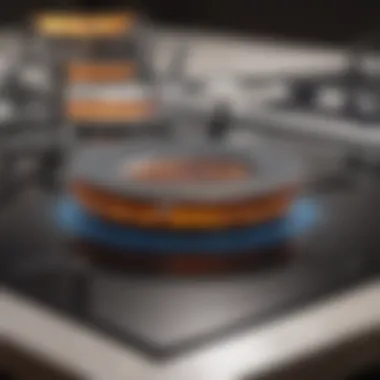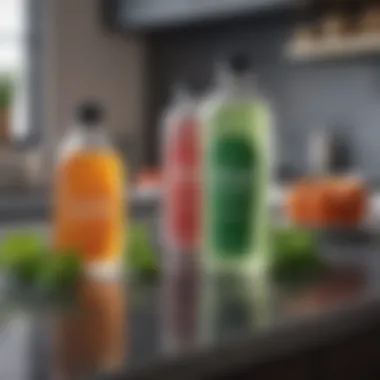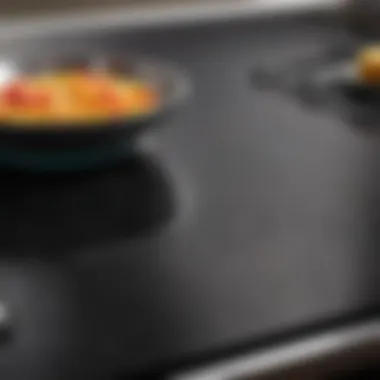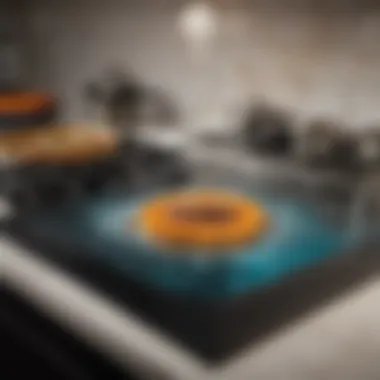Essential Tips for Cleaning Your Glass Cooktop


Intro
Cleaning a glass cooktop is a task that can feel overwhelming for many, especially considering that the wrong approach might lead to scratches or dullness over time. Glass cooktops are designed to be sleek and non-porous, which gives them an elegant appearance in any kitchen. However, they also smear easily, and any burned-on debris can require a careful strategy to remove effectively.
In this guide, you will explore various techniques that balance gentleness and effectiveness. You'll gain insight into appropriate cleaning products, safety practices, and consistent maintenance methods. These details are tailored for those who may have a demanding lifestyle yet still wish to preserve a pristine cooking surface. With diligence and the right approach, the glass cooktop can enhance your kitchen's aesthetic while providing a reliable cooking space.
Cleaning Basics
Understanding common best practices for cleaning glass cooktops is essential whenever you embark on the cleaning process. You must have suitable tools for the job. Much cleaning damage occurs from poor selections of materials.
The recommended items include:
- Soft microfiber cloths
- A non-abrasive sponge
- Glass cooktop cleaner
- Scraper tool since it helps effectively clean stubborn stains
- Warm water
Getting these supplies ready will set a solid foundation for keeping your cooktop looking fresh and pristine. Keep in mind that not all cleaning supplies will work, so provide caution with potential resources that can promote harm.
Next steps include exploring the meticulous cleaning technique and methods to choose suitable products, while keeping in disciplines an overall vision.
Understanding the Glass Cooktop
Cleaning a glass cooktop requires a clear understanding of the appliance itself. Knowing its material, features, and functions will greatly enhance your cleaning process and help maintain its aesthetics. A glass cooktop is both visually pleasing and functional; however, its surface is susceptible to scratches and stains if not cared for properly. This section aims to break down the fundamental aspects of a glass cooktop, highlighting why they matter where cleanliness and appearance are concerned.
Material Composition
Glass cooktops are primarily made from a specialized ceramic glass. This material is tailored to endure high temperatures and rapid heat changes, meaning it is both durable and suitable for cooking. The smooth surface offers advantages, including ease of cleaning and a modern look. However, it is essential to note that the composition does imply certain vulnerabilities. While resistant to scratches, the surface can still become damaged with inappropriate usage.
Factors to consider regarding material include:
- Heat Resistance: Capable of withstanding high cooking temperatures.
- Scratch Vulnerability: Prone to scratching from certain cookware types.
- Ease of Cleaning: The non-porous nature assists in maintaining cleanliness.
Common Features and Functions
Glass cooktops come with various functionalities designed for modern cooking, making them versatile tools in the kitchen. Key features often include:
- Smooth Operation: The flat surface allows diamonds and flat-bottomed cookware.
- Rapid Heating: Many models come with induction technology providing quick heat.
- Touch Controls: Certain designs integrate touch-sensitive controls making navigation easy.
- Indicator Lights: Warn users when the surface is hot, enhancing safety.
Together, these elements not only improve the cooking experience but also come into play during cleaning. Understanding their functions can help in selecting the right cleaning strategies that preserve the cooktop's performance.
The Importance of Regular Cleaning
Cleaning a glass cooktop is not merely an aesthetic preference. The importance of regular cleaning goes well beyond surface appeal and can greatly impact your cooking experience.
Preventing Stains and Residue Build-Up
A glass cooktop is prone to stains and residue build-up from food spills, grease, and cooking vapors. When these substances are allowed to sit and accumulate, they can become increasingly difficult to remove. This not only detracts from the clean appearance of the cooktop but may also lead to grime that, over time, can even etch the surface. Therefore, consistent maintenance is crucial.
- Make a habit of cleaning the cooktop after each use or whenever spills occur.
- Utilising a gentle cleaner specifically designed for glass cooktops can make a substantial difference.
- Regular cleaning protects the smooth texture of the surface and extends the life of the cooktop.


"A clean surface is not just pleasing to the eyes; it is essential for optimal functionality."
Maintaining Performance and Efficiency
Glass cooktops provide an elegant touch to kitchens, but their performance is contingent upon how well they are maintained. Regular cleaning is key to ensuring that heat distribution is even and effective. After cleaning, any residues leftover can lead to hot spots during cooking, which can affect both the quality of your food and uses of the cooker.
- By following a periodic cleaning schedule, you enhance heat efficiency.
- Efficient cooktops can also save you energy, which translates to lower utility bills over time.
- Regular cleaning ensures any newly treated food particles do not keep burning each time you cook, thus reducing bad smells in your kitchen.
Maintaining a clean cooktop is both a practical and effective approach to ensure long-lasting performance and appearance.
Essential Cleaning Supplies
Proper cleaning of a glass cooktop hinges on the use of appropriate supplies. These tools not only make the process efficient but also help preserve the integrity of the cooktop surface. Understanding which items are necessary can greatly improve the cleaning experience and outcome.
Recommended Cleaning Solutions
Choosing the right cleaning solution is fundamental in maintaining a glass cooktop. Generally, the most effective cleaning agents are specifically designed for glass or ceramic surfaces. These solutions often include:
- Vinegar solution: A mixture of equal parts vinegar and water is a natural option. It effectively tackles grease and most food stains without leaving behind harsh residues.
- Baking soda paste: Baking soda mixed with water forms a paste that can be applied to stubborn stains. Its gentle abrasiveness can remove grime without scratching the delicate surface.
- Commercial cooktop cleaners: Brands like Weiman and Cerama Bryte offer commercial solutions tailored specifically for glass cooktops. These products often contain protective agents to help maintain shine.
When selecting a cleaner, always ensure it's non-abrasive. Harsh chemicals may damage the cooktop or diminish its appearance over time. It's crucial to read labels for instructions and potential side effects on glass surfaces.
Tools Required for Effective Cleaning
In addition to cleaning solutions, having the right tools maximizes your effectiveness. Here are essentials:
- Soft microfiber cloths: These are ideal for gentle wiping without creating scratches on the glass. Microfiber traps dirt and grime better than regular cloths.
- Spatula or scraper: A plastic scraper helps lift tough food residues without risking damage to the surface. Metal scrapers can cause scratches and should be avoided.
- Non-abrasive scrubbers: Use sponge-like scrubbers that do not scratch, especially when dealing with greasy spots or dried food.
- Spray bottle: This is useful for storing and applying your vinegar solution or any other liquid cleaner.
It’s prudent to avoid steel wool or steel scouring pads as these can compromise the cooktop’s surface.
Ensuring you have the correct cleaning solutions and tools at hand significantly eases the process of maintaining your glass cooktop. Establishing a routine not only preserves its clarity but enhances overall kitchen cleanliness and efficiency.
Steps to Clean a Glass Cooktop
Cleaning a glass cooktop enhances both aesthetic appeal and cooking efficiency. Consistent maintenance prevents permanent stains, ensuring your cooktop remains durable and as attractive as it can when used regularly. This section elaborates on essential procedures for cleaning that everyone can follow with ease.
Initial Preparation
Before diving into the cleaning process, preparation is crucial. Clear the cooking surface by removing cookware and any food debris. This allows for a comprehensive clean without any distractions. Ensure the cooktop is cool to the touch. This avoid burns and protects the glass from thermal shock. If required, collect the necessary cleaning products and tools, and lay them out where they are easily accessible.
Applying the Cleaning Solution
Choose an appropriate cleaning solution tailored for glass cooktops. Elevate cleaning results by ensuring the solution is designed to cut through grease without harming the glass. Spray the cleaner evenly over the surface of the cooktop. This step not only saturates stains but also helps in dislodging residue that can be harder to clean. Following the instructions on the product's label can enhance effectiveness. Allow the solution to sit for a few minutes to let it penetrate and loosen grime thoroughly.
Scrubbing Techniques
Use a non-abrasive scrub pad or cloth during scrubbing. Sturdy pads can aid in removal of stubborn stains while ensuring the surface stays unharmed. Emphasize gentle, circular motions. Avoid excessive pressure, as this can lead to scratches. Areas with caked-on food debris may require additional focus, applying more cleaning solution if necessary to break it down.
Rinsing and Drying the Surface


Once you have scrubbed thoroughly, the next step is rinsing. Use a microfiber cloth dampened with plain water or arinse solution to wipe down the cooktop after scrubbing. It's essential to remove all traces of cleaner, as residue can cause further issues, such as streaking. After rinsing, dry the surfaces using a new, dry microfiber cloth. This reduces the likelihood of water spots. Proper drying not only preserves the shine but also preemptively minimizes future stains.
Regular cleaning maintains your glass cooktop's appearance and functionality.
Attempt these techniques regularly to keep your cooktop in excellent condition.
Dealing with Tough Stains
Tough stains on a glass cooktop can become a source of frustration, detracting from the appliance's visual appeal and making it difficult to maintain a clean cooking environment. Such stains include burnt food, grease, and various residues that not only affect the cooktop's aesthetic quality but may also cause permanent damage if left untreated. Understanding how to effectively deal with these tough stains is essential. This section outlines the importance of skillfully addressing these common challenges to keep the cooktop in a pristine condition while ensuring its performance and longevity.
Identifying Common Stains
First, identifying the type of stains present is vital for effective cleaning. The most frequently encountered tough stains on glass cooktops include:
- Burnt-on food: This appears as dark patches that adhere stubbornly to the surface, usually resulting from food overflows or spills during cooking.
- Grease splatters: Often caused by cooking oils, they tend to accumulate at the center or edges of the cooktop, becoming more difficult to remove over time if not addressed promptly.
- Watermarks: While seemingly harmless, water spots can tarnish the shiny surface if minerals are allowed to sit and dry on it.
By knowing what type of stain you are facing, it becomes easier to select the right methods and tools to effectively address the issue.
Effective Treatment Options
Once you know the nature of the stains, selecting the appropriate treatment is crucial:
- For burnt-on food: Start by soaking the area with a damp cloth or paper towel, allowing the residue to soften. Then, use a ceramic cooktop scraper at a shallow angle to gently remove the offending material. Be sure not to apply too much pressure, as excessive force can scratch the glass.
- For grease splatters: An effective option is to use a mix of vinegar and baking soda. Apply this paste onto the greasy areas and let it sit for about 15 minutes before wiping it off with a clean cloth.
- For watermarks: Use distilled white vinegar to spray the affected area. Wipe them clean using a soft microfiber cloth.
These approaches help ensure the appliance remains not just visually appealing but also functional.
When to Seek Professional Help
While most stains can be dealt with at home using the right techniques, some situations may warrant professional assistance. Signs that you might need to call for help include:
- Persistent stains: If after several attempts the stains are still not clearing, it may be advised to consult with specialists who have access to industrial-grade cleaning solutions.
- Scratches or etching: If the visible damage occurs, attempting DIY methods may worsen it. A specialist can analyze the damage and recommend suitable remediation.
- Maintenance queries: Any concerns regarding the overall functionality of the cooktop, or if you feel like it needs thorough cleaning that goes beyond noticeable stains, it is prudent to reach out to an expert.
Maintaining a glass cooktop’s appearance is achievable and essential for usability. By intelligently identifying the stains, employing effective treatments, and knowing when to involve professionals, users can ensure their cooktops stay in optimal condition.
Preventive Measures for Longevity
Keeping your glass cooktop in good condition is essential for its longevity. Regular care can minimize damage and maintain its aesthetics. When you use and clean today, think about tomorrow. Every effort made prevents bigger issues further down the line.
Using Cookware Appropriately
Choosing the right cookware is fundamental. Use pots and pans with flat bottoms. This provides even contact with the surface, preventing scratches. Materials such as stainless steel and enameled cast iron are great options. On the other hand, avoid cookware made from rough materials or materials not designed for glass surfaces.
Additionally, it’s important not to slide your cookware across the cooktop. Sliding can create scratch marks that are difficult to remove. Always lift pots when moving them. If you use heavier cookware, be cautious. Heavy pans dropped or placed too hard can crack or chip your cooktop.
Some key practices include: Inspecting your cookware for any dents that might lead to issues.
- Ensuring the bottom is clean to prevent transferring dirt.
- Avoiding using cookware smaller than the burner size.


Routine Maintenance Practices
Routine maintenance is necessary for extending the life of your cooktop. Establish habits that allow cleaning and maintenance to fit seamlessly into your schedule.
First, you should always wipe down the surface after every use. A light cleaning with a damp cloth helps remove spills and residues; procrastination will only encourage build-up.
In addition to cleaning after use, consider scheduling a deeper clean weekly. Use your preferred cleaning solution along with appropriate tools designed for cooktop cleaning. Knowing when your cooktop is particularly dirty can help you keep track of maintenance needs.
Consider these daily and weekly tasks:
- Daily: Wipe down, remove crumbs or spills right after cooking.
- Weekly: Schedule a full cleaning to remove tough stains and build-up.
Finding ways to incorporate routine actions into cooking can ensure that your cooktop remains in top shape for years, making for a longer-term investment in your kitchen.
Safety Precautions
In the realm of cooking, ensuring safety is paramount, especially when dealing with glass cooktops. These surfaces, while visually appealing, can be sensitive to both physical and chemical influences. Adhering to safety precautions is crucial, as it not only protects the cooking surface itself but also contributes to the overall safety of the kitchen environment.
Understanding Heat Sensitivity
Glass cooktops exhibit a unique relationship with heat. Unlike conventional gas or electric stovetops, they respond instantly to changes in temperature. This requires a particular attentiveness when cleaning. The residual heat from the cooktop can pose a burn hazard. Thus, it's essential to always check the temperature and ensure that the cooktop is cool before attempting any cleaning.
Using cold cleaning agents on a warm surface can also lead to cracking or thermal shock. Therefore, it is wise to allow sufficient time for the glass surface to cool down to a safe temperature, preventing avoidable incidents that could damage both the cooktop and the individual.
Key Points on Heat Safety:
- Allow the cooker to cool completely before cleaning.
- Use oven mitts to avoid contact with used cleaning agents, particularly when using hydrocarbon-based or commercial-grade cleaners.
Proper Handling of Cleaning Agents
Working with cleaning agents requires due diligence. Many substances available in today’s market can be effective at grime removal. However, not all are suited for glass cooktops and could potentially mar the surface or, worse, endanger personal safety.
First, always read the labels. Proper understanding of how to safely use each product is fundamental. For instance, certain abrasive cleaners or scouring pads may claim effectiveness but can scratch the glass surface. Others may release harmful chemicals when mixed improperly or applied to heated surfaces.
Recommendations for safe handling:
- Wear gloves: This limits skin exposure to chemicals that might cause irritation.
- Ventilate the area: Ensure the kitchen is well-ventilated when using strong cleaning agents, improving air circulation and reducing inhalation risks.
- Store cleaning supplies appropriately: Keep them out of reach of children and pets.
- Disposal considerations: Dispose of used cleaning agents respectfully and according to local regulations to minimize environmental impacts.
Culmination
The maintenance of a glass cooktop's cleanliness is an integral facet of kitchen management. When regular cleaning is prioritized, the appliances function optimally, providing an aesthetic appeal while ensuring safe cooking environments. Implementing a sufficient cleaning routine enhances the lifespan of the glass surface and prevents unsightly stains.
Recap of Key Cleaning Strategies
Cleaning a glass cooktop effectively boils down to a few core strategies. These include:
- Initial Preparation: Always start with cooled surfaces to avoid accidents.
- Applying the Cleaning Solution: Use a gentle yet effective cleaner to break down residue.
- Scrubbing Techniques: A soft cloth or specialized scrubber is critical for avoiding scratches.
- Rinsing and Drying: Make sure to wipe away any cleaner completely to maintain clarity.
Each method addresses crucial aspects, reducing scrub time while ensuring carriers for spills and stains are minimized.
The Value of Regular Maintenance
Consistent upkeep is pivotal for the longevity of any kitchen appliance, particularly glass cooktops. Regular maintenance helps to least burdensome cleaning sessions.
- Routine Cleaning: This allows users to keep grime and stains at bay, maintaining the aesthetic and functional integrity of the cooktop.
- Preventing Stains: Frequent attention stops things from setting, which saves time and effort long term.
Essentials like choosing the right cookware and routine checkup can significantly affect how often the surface needs deeper cleaning. By adopting these habits, cooks ensure that their tools remain as effective as possible.
Regular cleaning simplifies future tasks and preserves the smooth performance of your cooktop. Embrace it as part of your kitchen routine to reap ongoing benefits.







